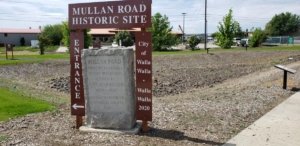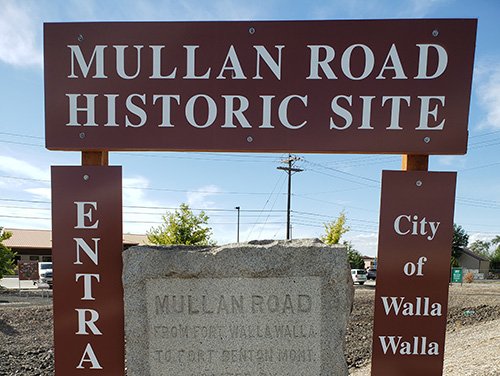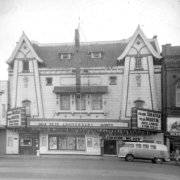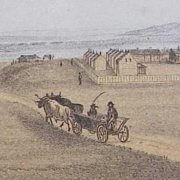Final work on historic Mullan Road through Walla Walla began 160 years ago
The following article was published in the Walla Walla Union-Bulletin’s and can be found at the UB’s site here.

The city of Walla Walla and Walla Walla 2020 have celebrated the importance of the Mullan Road with the dedication of the Mullan Road Historic Site. Extensive interpretive signage is at the corner of 13th Avenue and Abadie Street, as well as Historic Mullan Road street signs along 13th, the route of the road toward the Snake River.
In March 1858, U.S. Army Lt. John Mullan was given the task of building a wagon road from the steamship docks at old Fort Walla Walla on the Columbia River at Wallula to the new fort at the town of Walla Walla, and from there east across the Rocky Mountains to the steamship docks at Fort Benton on the Missouri River.
The initial construction by Mullan and his crew began in June 1859. After proceeding from Walla Walla to the Snake River, crossing at the mouth of the Tucannon River, Mullan continued north almost to present-day Cheney before heading east, south of Lake Couer d’Alene. This route was completed in October 1860.
On May 13, 1861, just over 160 years ago, Mullan left Walla Walla to began rebuilding and improving portions of the road by following a new eastern course north of Lake Couer d’Alene. It would provide a better route for pioneer families, miners and military supplies between the two major rivers on the first engineered highway in the Northwest, which became known as the Mullan Road.
The city of Walla Walla and Walla Walla 2020 have celebrated the importance of the road with the dedication of the Mullan Road Historic Site. Extensive interpretive signage is at the corner of 13th Avenue and Abadie Street, as well as Historic Mullan Road street signs along 13th Avenue, the route of the road toward the Snake River.
Walla Walla 2020 has also placed interpretive signage on state Route 124 just west of Prescott honoring a halfway house and forage station on the Mullan Road established in 1869 by the Benjamin Flathers family midway between Walla Walla and the road’s Snake River crossing.
In 1866, the Washington Territorial Legislature described the importance of the road to Walla Walla and other towns along the route in a memorial to Congress calling for needed repairs, key portions of which are below.
To the Honorable Senate and House of Representatives of the United States of America:
Your memorialists, the Legislative Assembly of the Territory of Washington, respectfully represent that the military wagon road from Wallula to Fort Benton on the Missouri river is for a great portion of the distance through the Coeur d’alene and Bitter Root mountains in an almost impassable condition for wagons, on account of fallen timber and destruction of bridges.
The necessity for a great national highway connecting the Missouri and Columbia rivers by a good and substantial wagon road was first brought to the notice of your honorable bodies as early as the year 1849. In 1857, John Mullan was ordered into the field, being fully supplied with all the necessary men and means, and completed the road in September, 1862.
There is a constant stream of population flowing into the region of country lying along and adjacent to this so-called “Mullan Road.” The immigrant who is seeking farming land comes on down to the Walla Walla and other rich valleys lying along the western terminus of the road, and thence on to Puget Sound.
There is at the present time a population of over one hundred thousand inhabitants in the Territories of Washington, Idaho and western Montana. Rich deposits of gold, silver, copper, lead and iron are constantly being discovered and rapidly developed. Mining towns are springing into existence in all parts of the newly settled region.
The Walla Walla valley, including that portion which lies in the State of Oregon, has produced this season, (1866) 500,000 bushels of wheat; 250,000 bushels of oats; 200,000 bushels of barley; 150,000 bushels of corn; 170,000 pounds of beans; 4,500 head of hogs; 1,800 head of horses; 2,500 head of cattle.
From Jan. 1, to Nov. 15, 1866, 1,500 head of horses have been purchased by individual miners at Walla Walla horse markets; 2,000 miners have outfitted at Walla Walla; 5,000 head of cattle were driven from Walla Walla to Montana; 6,000 mules have left the Columbia river and Walla Walla loaded with freight for Montana; 52 light wagons with families, have left Walla Walla for Montana; 31 wagons with immigrants have come through from the States via the “Mullan Road,” a portion of whom settled in Walla Walla valley and the remainder crossed the Columbia river at Wallula and settled on the Yakima River or passed on to Puget Sound; not less than 20,000 persons have passed over the “Mullan Road” to and from Montana during the past season; 1,000,000 dollars in treasure has passed down through Walla Walla and Wallula during the same period.
The Walla Walla valley contains six flouring mills, six saw mills, two planing mills, two distilleries, one foundry and fifty two thrashing, heading and reaping machines.
The Oregon Steam Navigation Company have run a daily line of boats to Wallula (Sundays excepted) during the past season up to the fourth day of November; since that time the boats have made four trips per week. These boats are of the capacity of from seventy-five to two hundred tons burthen, and giving the very lowest estimate, these boats have landed not less than five thousand tons of freight at Wallula during the season.
As early as 1862, about the time the Fort Benton wagon road was completed, the Oregon Steam Navigation Company landed at Wallula, from the 5th day of July to the 11th day of October inclusive, 1705 tons of freight, making three trips per week, which is an average of over forty tons per trip.
The Government has a large warehouse at Wallula, a quar termaster’s agent in charge, and all the Government supplies for Fort Walla Walla, Fort Boise and a large proportion of those for Forts Colville and Lapwaii are landed there. Freight is landed at Wallula for Lewiston, Florence Pierce City, Elk City and Oro Fino during the spring and fall, and for Helena, Black foot City, Deer Lodge, Hell Gate, Bitter Root valley, Cariboo, Kootenai and Pend-d’oreille lake, at all seasons of the year, ice not preventing.
Wallula, on the great bend of the Columbia river, stands in the same position to Washington, Idaho and western Montana Territories, that Fort Benton, on the Missouri river, does to the eastern portion of Montana.
Wheat cannot be purchased anywhere in the United States at what it is now daily being sold for at Walla Walla, sixty cents per bushel. Oats command from one to one and one-half cents per pound; barley from one to one and one-quarter cents per pound. Last year the merchants of Walla Walla shipped over 600,000 pounds of oats to Oregon, and 113,000 pounds of wool and a large quantity of potatoes and onions.
Believing that we have in as small a space as possible presented some of the many reasons showing the great necessity for the immediate opening of the Walla Walla and Fort Benton wagon road, commonly called the “Mullan Road,” we will therefore only further state that the Post Office Department has established a mail route from Wallula to Helena, making Wallula a distributing office, and that by opening the road we are assured that we will soon have what the requirements of the country and the number of inhabitants demand, a mail coach on the route instead of a train of pack horses.
Thanks to city attorney Tim Donaldson for passing on a copy of this memorial. Further information on the Mullan Road Historic Site in Walla Walla and the halfway house at Prescott is on the Walla Walla 2020 website, ww2020.net/history-websites, along with information on other area historic sites.
Daniel Clark is a retired attorney who coordinates the Walla Walla 2020 Historic Sites & Markers Project, and is the author of Historic Sites and Markers of Walla Walla County.











